Traingle along a curve?
-
Hi all,
I would consider myself a quite experienced user of sketchup, however I have been unable to solve the problem of getting a triangle along a curve.
I have attached what I have attempted to do... But the result that I have got is not what I would like.
I would prefer the triangle to follow the curve so that the whole thing tapers towards its end point... any suggestions?
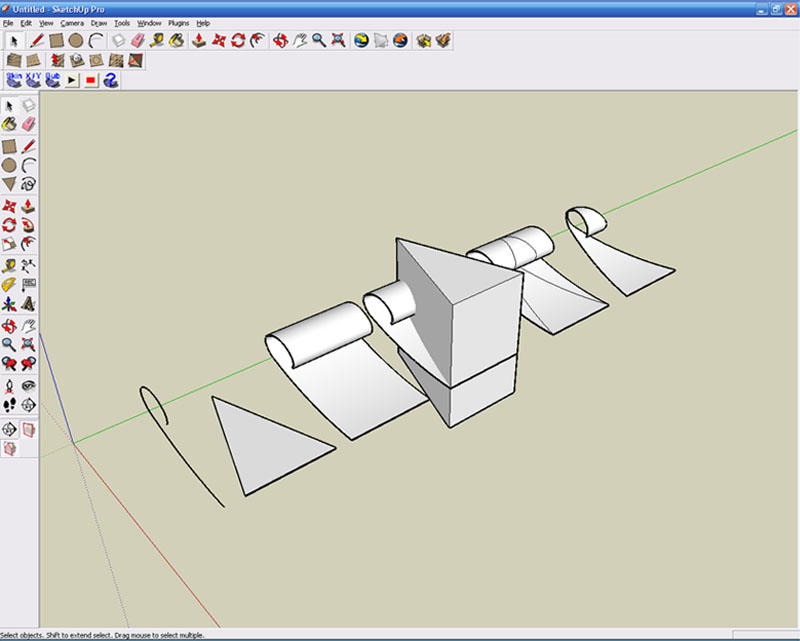
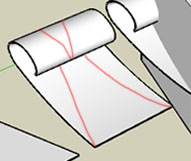
-
Have you tried Fredo's Tools on surface plugin yet?
Another ("native" approach could be to turn on hidden geometry and draw the segments of the curved triangle by hand. Not a too big curve so it could be done in about 5-10 minutes.
-
This is just a quick reply, and so I haven't had a chance to try this out, but...
- Draw the rectangle
- Draw the triangle directly on the rectangle
- Delete the long side of the rectangle and then replace each side with two separate lines (effectively two rectangles jointed together. Make the join line the start of the curve.
- Use the divide tool to divide the shorter lines on each side of the rectangle (the lines that bound the curved section of the triangle) into, say, 10 short lengths
- Draw lines between the end points of parallel and adjacent lengths(across the rectangle)
- Use the rotate tool to rotate each small rectangular area an incremental amount to form the curve.
- Delete the unwanted geometry
- Use weld.rb to weld the sides of the curved triangle back together.
Regards,
Bob -
the tools on surface plugin is giving me some strange results... Using the line on surface tool and going from corner to midpoint I get an overlap and the forms created dont resemble much of a triangle.. am i going about this the wrong way?
watkins, I'm finding it pretty hard to follow your instructions?
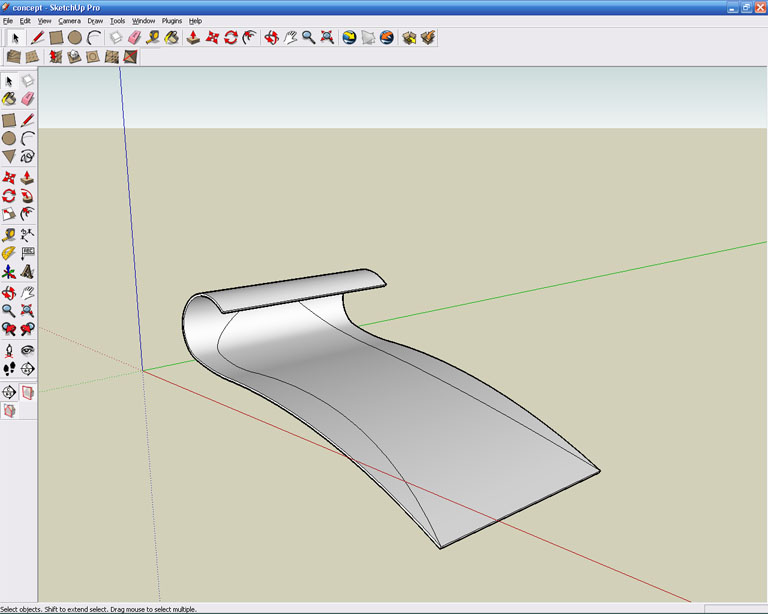
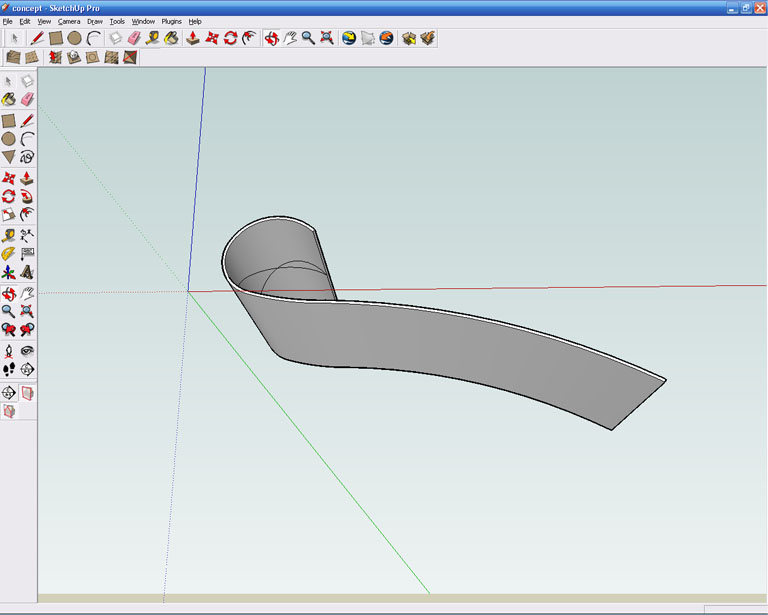
-
Another approach might be to draw the triangular form on to a flat plane then subdivide it lots before using FFD to curve it in to shape.
-
A slightly simpler approach. The more segments you use the smoother the curve. Use eraser+ctrl to hide unwanted geometry.
-
theolwakachangchang,
You could try creating a texture image of a triangle, then 'paint' the texture on your original curve. From there, draw line entities, tracing on the applied texture. I need to try this out myself (this is just an idea, right now -- I'm not sure it'll work.)
Regards,
Taff -
the only problem with drawing the triangle on a flat plane first and then manually curving it is that I would need a huge amount of sections to achieve what I want... I would like to export the final product to another program for rendering, so I'm going to need the curve pretty free flowing
-
have just tried your idea TaffGoch, was a great idea but sketchup only places the texture on 1 segment of the curve

-
theolwakachangchang,
I worked on this a while, trying to learn SketchUp's idiosyncracies, regarding wrapping a texture around a curved surface.
The instructions in the SketchUp Users Guide can be found by searching for 'wrap'
It took some experimenting with the 'eyedropper' -- <alt>paintbucket -- picking texture from a 'strip' then painting the adjacent strip. Repeat this for each strip (with hidden lines visible.)
It was a pain to get it to work, until I resized the texture image, using the 'material edit' tab. I set the triangle image dimensions using the size boxes at the bottom of the edit dialog, while the aspect-ratio 'chain' was clicked to break it (allow a change to the aspect ratio.) I set the image dimensions to match the dimensions of the curved surface. Trying to resize the texture, using the texture-pins did not work for me.
It took a lot of playing around, but once I got the hang of it, it went pretty quick. I didn't think it would take me so long to learn how to get the texture to follow the curve. After getting the surface textured properly, tracing line entities on the curved surface was the easiest part of the construction.
Both, a preview image, and the model, are attached.
Regards,
Taff
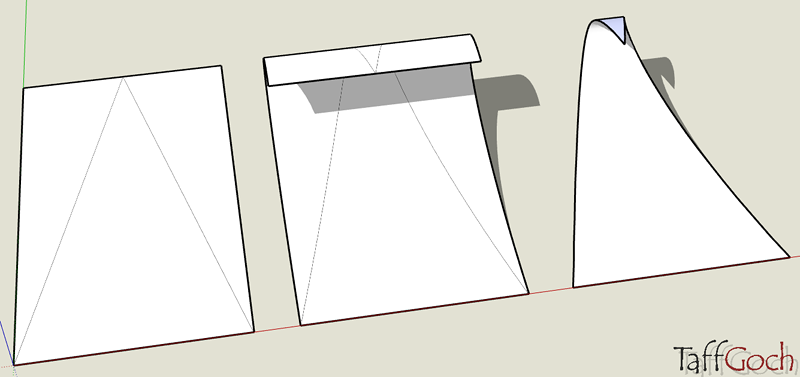
-
Dear TaffGoch,
This is just the kind of thing I look for when I log on.
Could you do a 'step-by-step' and then post it in the tutorial section as I am not too sure that I understand all the steps involved. I do not use textures very often and so a few of the techniques you describe are unfamiliar.
Kind regards,
Bob -
TaffGoch... thanks a lot for that
 all is working well now. I couldn't get the texture pins working for me either, I completely overlooked the material editor
all is working well now. I couldn't get the texture pins working for me either, I completely overlooked the material editor... Just a final question, how did u trace the lines?? The tools on surface plugin?
-
I think TaffGoch just turned on hidden geometry and then used the pencil tool to draw the individual segments. I have just opened his skippy and tried it myself. You need to zoom in to place the line segments correctly.
I must have a go at this some time as it never crossed my mind to use a texture to create geometry on a curved surface.
Kind regards,
Bob -
@theolwakachangchang said:
...how did u trace the lines??
Bob guessed right -- I merely traced, with the line tool, on top of the image-textured surface, placing endpoints at the apparent intersection of the triangle-image 'edges' with the actual hidden edges (dashed.) I only traced one half, then copied and flipped that series of line segments, to produce a precise mirror-image.
@watkins said:
Could you do a 'step-by-step' and then post it in the tutorial section as I am not too sure that I understand all the steps involved.
Let me work on it a while. I need to review everything I did wrong before getting it right (sort the wheat from the chaff.) Once I have it reliably in-mind, I'll beef-up the model.
Taff
-
@watkins said:
Could you do a 'step-by-step'...
Bob, take a look at the attached .skp file, to see if it answers your questions.
Taff
-
Dear Taff,
Just a quick acknowledgement and thanks for the tutorial. Too late to look at it now (23:30), but will do so in the morning.
Night, night.
Bob
-
Dear Taff,
A most excellent tutorial. Many thanks for taking the time to put it together.
Gaieus,
This needs to be moved to the tutorial section.
Kind regards,
Bob -
@watkins said:
Many thanks for taking the time to put it together.
I'm glad to hear the instructions were sufficiently clear (the second time around)

@watkins said:
...it never crossed my mind to use a texture to create geometry on a curved surface...
I refined the process while producing geometry on troublesome curved aircraft surfaces (my X-15 rocket planes in the 3D Warehouse.) Most geometry could be produced with (faster) intersections, as first attempted by theolwakachangchang, but sometimes a new approach must be devised.
Regards,
Taff
Advertisement







